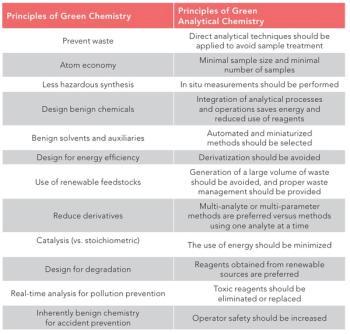Key Points:
- Volatile organic compounds (VOCs) directly influence the aroma, flavor, and perceived freshness of food and beverages. Analyzing VOCs helps maintain product consistency, detect adulteration, and understand the impact of cultivation and processing on sensory characteristics.
- Combining high-capacity sorptive extraction with GC–MS and chemometric analysis enables fast, solvent-free, and scalable VOC profiling.
- Statistical analysis of VOC data (e.g., PCA) reveals subtle chemical differences between product types, as demonstrated in tea varieties.
Volatile organic compounds (VOCs) determine the flavours and aromas of the food and drinks we consume and are responsible for how the consumer perceives the freshness and quality of the product. Analysis of VOCs is essential to maintain product consistency by detecting whether growing, refining, and production processes have an impact on the smell and taste of the product or whether a product has been tampered with.
The flavours and aromas of food and drink are determined by the presence of the volatile organic compounds (VOCs) they contain. The differences in VOC profiles can have a huge influence on consumer preference and can significantly affect the perception of freshness, quality, and sensory experience—even when present at extremely low levels. This makes their analysis critical to maintain a consistent level of product quality, to detect authenticity or adulteration, and to analyze the effects of any refining and production processes.
While detailed profiling of these volatile compounds using automated sorptive extraction and advanced chemometric data-mining for gas chromatography–mass spectrometry (GC–MS) has been applied to tea (see case study), this approach for exploring food sample variability can be extended to a wide range of foodstuffs. This includes spices, dairy, baked goods, meat, and even fermented products.
Challenges of Analysis
A major challenge in VOC analysis is the need for a method that is fast, solvent-free, and doesn’t generate any hazardous waste. The approach needs to be scalable, able to be performed manually for small studies but fully automatable for when high sample throughput is required. Most
importantly, it should be comprehensive and able to detect compounds across a wide volatility range, and sensitive enough to identify trace‑level compounds while still accurately capturing more abundant analytes. Typical solvent‑based extraction methods have previously been found to be laborious and environmentally unfriendly with the potential to introduce unwanted contaminants.
High-capacity sorptive extraction using probes, combined with GC separation and mass spectrometric detection, has been shown to meet analytical criteria by delivering consistent, reliable, and reproducible results.
Using a principal components analysis (PCA) plot, the sample results generated can be swiftly grouped according to type, and compounds that vary most among those types can be identified. This allows fast extraction of the most useful information from the data.
This workflow ensures enhanced sensitivity for both abundant and trace‑level compounds with a broad volatility range. It also provides automation capability to reduce hands-on time and gives improved reproducibility.
This approach, demonstrated here using tea samples, showed clear differences in VOC compositions and delivered rapid identification of key chemical differences responsible for the distinctive flavours and aromas for the samples investigated.
Experimental
Case Study: Understanding Flavour Complexity in Tea: In tea, VOC profiles undergo significant variations because of the growing, harvesting, and processing techniques employed. It is these changes that make oxidized teas smell and taste so different from non‑oxidized green teas.
Samples: The tea study was conducted using four loose leaf tea varieties—green, oolong, black, and Assam—purchased from a local supermarket.
The tea was ground to a coarse powder, of which 5 g was steeped in 220 mL hot water for nine min. A 1-mL measure of the resulting brews was transferred to a headspace vial prior to capping.
Probe Sampling: Sampling of the tea was performed using HiSorb high-capacity sorptive extraction probes (Markes International) containing 30 µL of PDMS/CWR/DVB as the sorptive phase.
An incubation time of 20 min, with an incubation temperature of 60 °C, and an extraction time of 30 min was used.
Using prep-ahead functionality and optimized parameters, each sample was prepared and extracted while the previous sample ran on the GC system. This allowed injection of each sample onto the GC–MS system to be performed every 35 min.
Software: Automated data mining with chemometric comparisons were conducted in ChromCompare+ (SepSolve Analytical).
Results and Discussion
Tea varieties showed distinct VOC profiles. Across the four tested tea varieties, 94 compounds were detected (Figure 1). The majority of these had known aroma properties. This demonstrated the challenge in determining the compounds causing variations in the perceived quality of tea varieties and is consistent with the rich sensory experience that tea products are known for.
Terpenes, such as linalool, limonene, and eucalyptol, which are well-known for conferring strong but pleasant aromas to foods and beverages were prominent among the compounds detected. Aldehydes and furans, which confer green, leafy notes and sweet, woody notes, respectively, were also present. Most of the aroma descriptions reflected the botanical origin of tea, with terms such as fruity, woody, floral, and herbal being common.
Notably, green tea had the fewest VOCs and was the only kind to contain p-anisaldehyde, which gives it a distinct sweet, anise-like scent. It was also free of aldehydes like heptanal and (E,E)-2, 4-heptanedienal, which give fatty scents, and 1-ethyl-2-pyrrolecarboxaldehyde, which imparts a burnt aroma. This accounts for the fresher, lighter quality of green tea when compared to
oxidized types.
Notable Correlations
Replicates of the same tea variety clustered closely, highlighting the reproducibility of high-capacity sorptive extraction. Oolong tea (purple cluster) appeared to be most distinct because it was strongly separated from all other tea varieties along the PC 1 axis, while the other varieties were separated along the PC 2 axis (Figure 2). The green and black teas (yellow and blue clusters) were chemically most similar, while Assam tea (red cluster) diverged somewhat from these.
These results correlate with the peak identification analyses shown in Table 1, which highlights oolong tea as containing many compounds that were not present in any other variety, while the Assam, black and green tea varieties shared many compounds.
Next, the key differentiators of the tea varieties, as identified through chemometric (statistical) analysis, were examined. Figures 3a–c show boxplots of three example compounds and their abundance in each of 40 tea samples. Again, good reproducibility was shown between replicates of the same tea, while differences in abundance among tea varieties were clear.
Conclusions
The 94 compounds identified in tea came from a wide range of chemical classes, with aldehydes and terpenes being most prominent.
Data-mining and statistical analysis of the chromatograms showed that replicates of the same tea variety were very similar, indicating excellent reproducibility and highlighting subtle differences between tea varieties responsible for contrasts in flavour and aroma. The ability to detect these minor differences in tea can be used in quality control, in the development of new tea products, and to detect instances of food fraud among other applications.
Future Applications of VOC Profiling
Researchers are continuing to apply these analytical techniques to investigate the impact of food processing methods on health-related compounds such as antioxidants and flavour precursors. This offers new possibilities for innovation in food product development.
As food science advances, the need for precise, reproducible, and scalable methods for VOC analysis will continue to grow. By leveraging sorptive extraction, automated enrichment, and chemometric data analysis, food producers and researchers can gain unprecedented insights into flavour chemistry and how they correlate to perceived food and drink quality.
Lucy Hearn received an MSc in green chemistry and sustainable industrial technologies from the University of York, UK, where her final-year project focused on the extraction and isolation of cannabinoids from hemp using supercritical CO2. She later took up the role of application specialist at Markes, providing technical and application support to users around the world, and developing applications using extraction and enrichment techniques for GC–MS.
Rebecca Cole received a BSc in genetics from the University of Cardiff, UK, and subsequently undertook research for a PhD at the University of Bristol on the population genetics of parasitic nematodes. Subsequently, Rebecca joined Markes International as an application specialist and is involved in applications using extraction and enrichment techniques for GC–MS.





